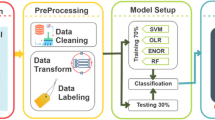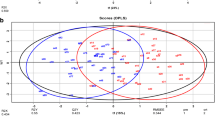Abstract
Vitamin D deficiency is prevalent in the Arabian Gulf region, especially among women. Recent researches show that, the vitamin D deficiency is associated with mineral status of patient. Therefore, it is important to assess the mineral status of patient to reveal the hidden mineral imbalance associated with vitamin D deficiency. A well-known test such as the red blood cells is fairly expensive, invasive, and less informative. On the other hand, a hair mineral analysis can be considered an accurate, excellent, highly informative tool to measure mineral imbalance associated with vitamin D deficiency. In this study, 120 apparently healthy Kuwaiti women were assessed for their mineral levels and vitamin D status by hair and serum samples, respectively. This information was used to build a computerized model that would predict vitamin D deficiency based on its association with the levels and ratios of minerals. The model introduces a two-stage reduction technique based on BPSO and rough set theory as attribute reduction and rules extraction to predicting vitamin D deficiency. The results show that the proposed model (RS + BPSO), not only can effectively detect the deficiency in vitamin D, but can also provide valuable information with regard to the mineral imbalance as a cause of deficiency which should be addressed in any treatment management. To the best of our knowledge, this is the first work that predicts vitamin D deficiency based on hair minerals analysis.




Similar content being viewed by others
References
Bassil D, Rahme M, Hoteit M, Fuleihan GE-H (2013) Hypovitaminosis D in the Middle East and North Africa. Derm Endocrinol 5(2):274–298
Mishal A (2001) Effects of different dress styles on vitamin D levels in healthy young Jordanian women. Osteoporos Int 12(11):931–935
Siddiqui A, Kamfar H (2007) Prevalence of vitamin D deficiency rickets in adolescent school girls in Western region, Saudi Arabia. Saudi Med J 28(3):441–444
Alyahya K, Lee WTK, Al-Mazidi Z, Morgan J, Lanham-New S (2014) Risk factors of low vitamin D status in adolescent females in Kuwait: implications for high peak bone mass attainment. Arch Osteoporosis 9:1–11
Holick MF (2007) Vitamin D deficiency. N Engl J Med 357(3):266–281
Javaid M, Crozier S, Harvey N, Gale C, Dennison E, Boucher B, Arden N, Godfrey K, Cooper C (2006) Maternal vitamin D status during pregnancy and childhood bone mass at age 9 years: a longitudinal study. Lancet 367(9504):36–43
Autier P, Boniol M, Pizot C, Mullie P (2014) Vitamin D status and ill health: a systematic review. Lancet Diabetes Endocrinol 2:76–89
Kulie T, Groff A, Redmer J, Hounshell J, Schrager S (2009) Vitamin D: an evidence-based review. JABFM 22(6):698–706
Reid IR, Bolland MJ, Grey A (2014) Effects of vitamin D supplements on bone mineral density: a systematic review and meta-analysis. Lancet 383:146–155
Watts D (1990) Nutrient interrelationships minerals–vitamins–endocrines. J Orthomol Med 5(1):11–19
Nguyen T, Khosravi A, Creighton D, Nahavandi S (2015) Classification of healthcare data using genetic fuzzy logic system and wavelets. Expert Syst Appl 42(4):2184–2197
Srimani PK, Koti MS (2011) The impact of rough set approach on medical diagnosis for cost effective feature selection. IJCR 3(12):175–178
Inbarania HH, Azarb AT, Jothi G (2014) Supervised hybrid feature selection based on PSO and rough sets for medical diagnosis. Comput Methods Progr Biomed 113:175–185
Macas M, Bhondekar AP, Kumar R, Kaur R, Kuzilek J, Gerla V, Lhotská L, Kapur P (2014) Binary social impact theory based optimization and its applications in pattern recognition. Neurocomputing 132:85–96
Kumar SU, Inbarani HH (2015) A novel neighborhood rough set based classification approach for medical diagnosis. Proc Comput Sci 47:351–359
Rzepiński T (2014) Randomized controlled trials versus rough set analysis: two competing approaches for evaluating clinical data. Theor Med Bioeth 35(4):271–288
Guo S, Lucas RM, Ponsonby A-L, The Ausimmune Investigator Group (2013) A novel approach for prediction of vitamin D status using support vector regression. PLoS One 8(11):e79970
Wilson L (2010) Nutritional balancing and hair mineral analysis, 4th edn. LD Wilson Consultants, Inc, Prescott
Ahmad G, Kuhi H, Mohit A (2013) A review hair tissue analysis: an analytical method for determining essential elements, toxic elements, hormones and drug use and abuse. Int Res J Appl Basic Sci 4(11):3675–3688
Qayyum MA, Shah MH (2014) Comparative study of trace elements in blood, scalp hair and nails of prostate cancer patients in relation to healthy donors. Biol Trace Elem Res 162:46–57
Pawlak Z (1982) Rough sets. Int J Comput Inf Sci 11:341–356
Talbi E-G, Jourdan L, Garcia-Nieto J, Alba E (2008) Comparison of population based metaheuristics for feature selection: application to microarray data classification. In: Proceedings of AICCSA 2008
Kennedy J, Eberhart RC (1999) The particle swarm: social adaptation in information processing systems. In: Corne D, Dorigo M, Glover F (eds) New ideas in optimization. McGraw-Hill, London
Shi Y, Eberhart RC (1998) Parameter selection in particle swarm optimization. In: Evolutionary programming VII: proceedings of the 7th annual conference on evolutionary programming, New York, pp 591–600
Kennedy J, Eberhart RC (1997) A discrete binary version of the particle swarm algorithm. In: Proceedings of the world multi conference on systemics, cybernetics and informatics, Piscataway, pp 4104–4109
Wang X, Yang JXT, Xia W, Jensen R (2007) Feature selection based on rough sets and particle swarm optimization. Pattern Recogn Lett 28:459–471
Inbarani HH, Banu PKN, Andrews S (2012) Unsupervised hybrid PSO-quick reduct approach for feature reduction. In: Proceedings of international conference on recent trends in information technology, pp 11–16
Zuhtuogullari K, Allahverdi N, Arikan N (2013) Genetic algorithm and rough sets based hybrid approach for reduction of the input attributes in medical systems. Int J Innov Comput Inf Control 9(7):3015–3037
Saini S, Rambli DRA, Zakaria N, Sulaiman S (2014) A review on particle swarm optimization algorithm and its variants to human motion tracking. Math Probl Eng. doi:10.1155/2014/704861
Zhong N, Skowron A (2001) Rough sets based knowledge discovery process. Int J Appl Math Comput Sci 11(3):603–619
Bazan JG, Szczuka M (2005) The rough set exploration system, transactions on rough sets III. Springer, Berlin, pp 37–56
Group of logic in poland. RSES. http://logic.mimuw.edu.pl/~rses
Own HS, Hassanien AE (2009) Rough sets: a medical knowledge discovery (RS-MKD) scheme for prostate cancer data analysis. Int J Comput Sci Softw Technol (IJCSST) 2(2):999–1005
Lamberg-Allardt C, Brustad M, Meyer H, Steingrimsdottir L (2013) Vitamin D—a systematic literature review for the 5th edition of the nordic nutrition recommendations. Food Nutr Res 5:57
Wang Q (2014) A hybrid sampling SVM approach to imbalanced data classification, abstract and applied analysis. Hindawi Publishing Corporation, Cairo. doi:10.1155/2014/972786 (SD-008)
Own HS, Abraham A (2012) A new weighted rough set framework based classification for egyptian neonatal jaundice. Appl Soft Comput Elsevier 12(3):999–1005
Schwalfenberg GK, Genuis SJ (2015) Vitamin D, essential minerals, and toxic elements: exploring interactions between nutrients and toxicants in clinical medicine. Sci World J. doi:10.1155/2015/318595
Kebapcilar A, Kulaksizoglu M, Kebapcilar L, Gonen M, Ünlü A, Topcu A, Demirci F, Taner C (2013) Is there a link between premature ovarian failure and serum concentrations of vitamin D, zinc, and copper? Menopause 20(1):94–99
Villagomez A, Ramtekkar U (2014) Iron, magnesium, vitamin D, and zinc deficiencies in children presenting with symptoms of attention-deficit/hyperactivity disorder. Children 1(3):261 (1994)
Moon J (1994) The role of vitamin D in toxic metal absorption: a review. J Am Coll Nutr 13(6):559–564
Rodriguez-Martinez MA, Garcia-Cohen EC (2002) Role of Ca(2+) and vitamin D in the prevention and treatment of osteoporosis. Pharmacol Theraputics 93(1):37–49
Zittermann A (2013) Magnesium deficit—overlooked cause of low vitamin D status? BMC Med 11:229
Deng X, Song Y, Manson JE, Signorello LB, Zhang SM, Shrubsole MJ, Ness RM, Seidner DL, Dai Q (2013) Magnesium, vitamin D status and mortality: results from US National Health and Nutrition Examination Survey (NHANES) 2001 to 2006 and NHANES III. BMC Med 11(187):1741–7015
Worker NA, Migicovsky BB (1961) Effect of vitamin D on the utilization of zinc, cadmium and mercury in the chick. J Nutr 75:222–224
Kechrid Z, Hamdi M, Naziroglu M, Flores-Arce M (2012) Vitamin D supplementation modulates blood and tissue zinc, liver glutathione and blood biochemical parameters in diabetic rats on a zinc-deficient diet. Biol Trace Elem Res 148(3):371–377
Masuhara T, Migicovsky BB (1963) Vitamin D and the intestinal absorption of iron and cobalt. J Nutr 80:332–336
Terry J (1994) The major electrolytes: sodium, potassium, and chloride. J Intraven Nurs 17(5):240–247
Archibeque-Engle SL, Tessari JD, Winn DT, Keefe TJ, Nett TM, Zheng T (1997) Comparison of organochlorine pesticide and polychlorinated biphenyl residues in human breast adipose tissue and serum. J Toxicol Environ Health 52:285–293
Ross AC (2011) The 2011 report on dietary reference intakes for calcium and vitamin D. Public Health Nutr 14(5):938–939
Acknowledgments
The authors are gratefully thanks the Public Authority for Applied Education and Training (PAAET), Kuwait for providing the dataset used in this study.
Author information
Authors and Affiliations
Corresponding author
Rights and permissions
About this article
Cite this article
Own, H.S., Alyahya, K.O., Almayyan, W.I. et al. Rough set–BPSO model for predicting vitamin D deficiency in apparently healthy Kuwaiti women based on hair mineral analysis. Neural Comput & Applic 29, 329–344 (2018). https://doi.org/10.1007/s00521-016-2454-x
Received:
Accepted:
Published:
Issue Date:
DOI: https://doi.org/10.1007/s00521-016-2454-x




